Post Graduate Report: Advanced Tour and Travel Brochure Operation
VerifiedAdded on 2022/01/19
|7
|2728
|128
Report
AI Summary
This report, prepared for postgraduate studies in Hospitality Management at Hawassa University, analyzes the meaning, design, and format of tour brochures within the context of the advanced tour and travel business operation. It covers the essential components of a tour brochure, including the information required, design considerations, and various formats. The report also discusses the obligations affecting tour brochures, the role of e-brochures, negotiation strategies with printers, and effective distribution methods. It emphasizes the importance of brochures in attracting customers, providing clear information, and stimulating interest in travel packages. The report references key literature and provides a comprehensive overview of tour brochure development and implementation in the tourism industry.
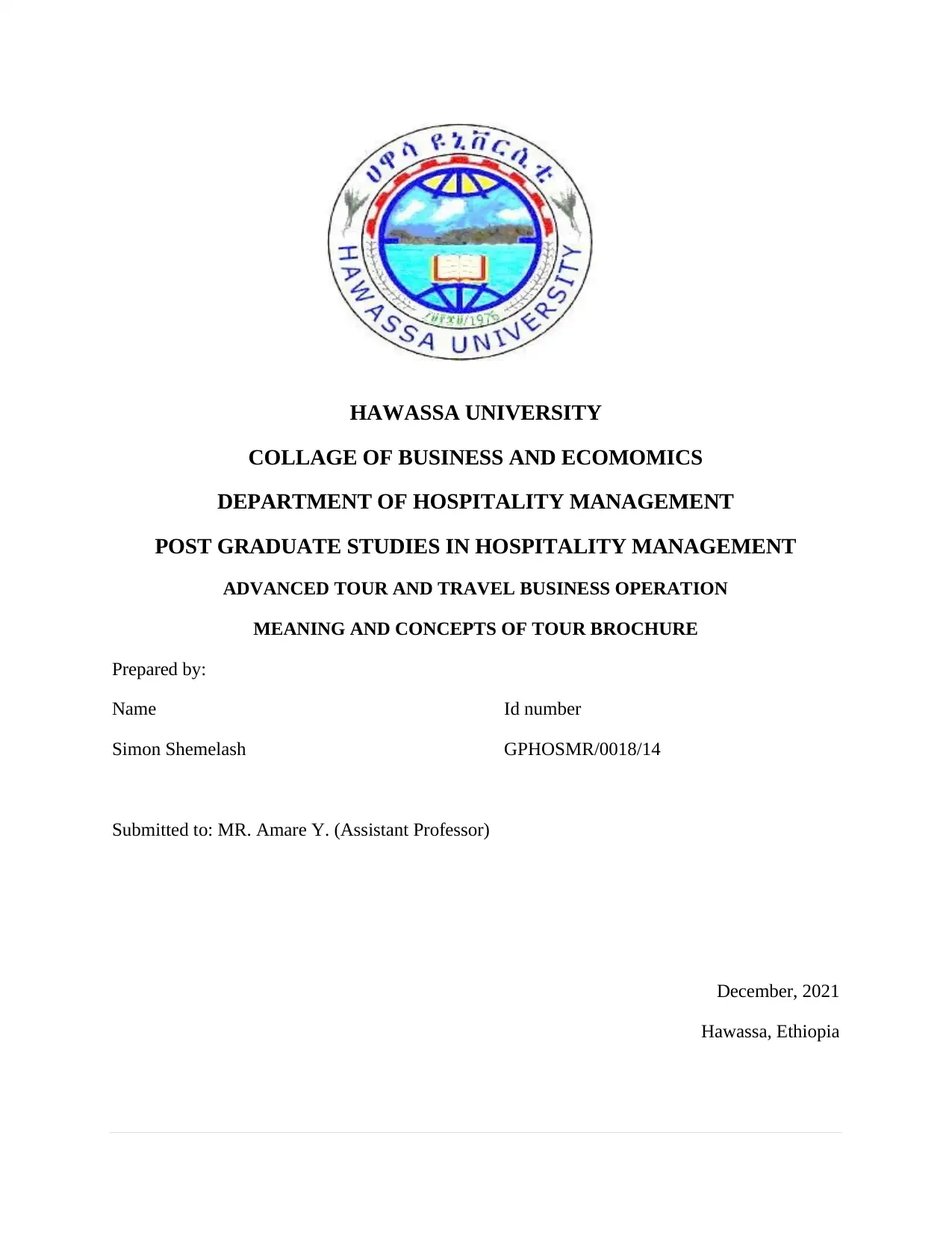
HAWASSA UNIVERSITY
COLLAGE OF BUSINESS AND ECOMOMICS
DEPARTMENT OF HOSPITALITY MANAGEMENT
POST GRADUATE STUDIES IN HOSPITALITY MANAGEMENT
ADVANCED TOUR AND TRAVEL BUSINESS OPERATION
MEANING AND CONCEPTS OF TOUR BROCHURE
Prepared by:
Name Id number
Simon Shemelash GPHOSMR/0018/14
Submitted to: MR. Amare Y. (Assistant Professor)
December, 2021
Hawassa, Ethiopia
COLLAGE OF BUSINESS AND ECOMOMICS
DEPARTMENT OF HOSPITALITY MANAGEMENT
POST GRADUATE STUDIES IN HOSPITALITY MANAGEMENT
ADVANCED TOUR AND TRAVEL BUSINESS OPERATION
MEANING AND CONCEPTS OF TOUR BROCHURE
Prepared by:
Name Id number
Simon Shemelash GPHOSMR/0018/14
Submitted to: MR. Amare Y. (Assistant Professor)
December, 2021
Hawassa, Ethiopia
Paraphrase This Document
Need a fresh take? Get an instant paraphrase of this document with our AI Paraphraser
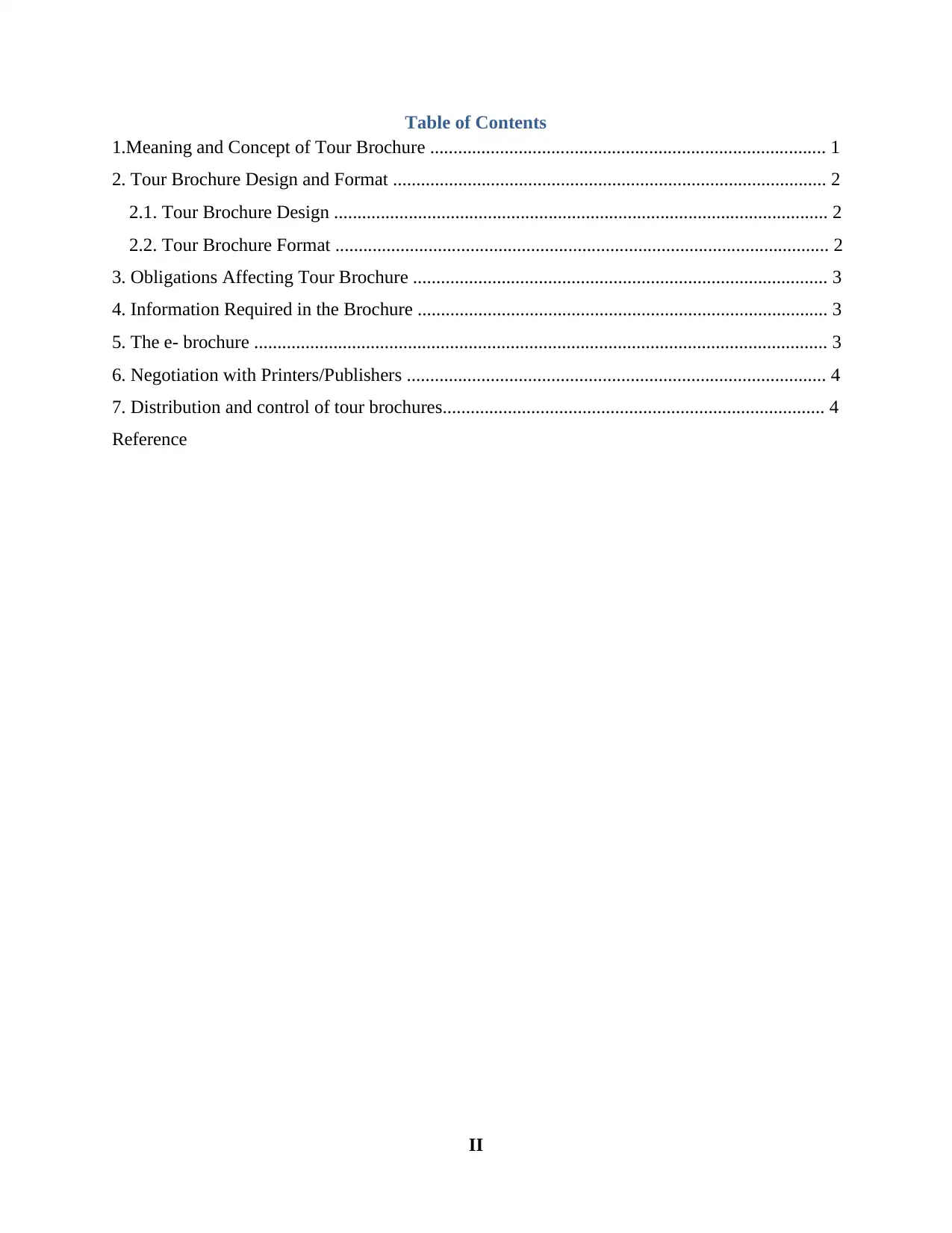
II
Table of Contents
1.Meaning and Concept of Tour Brochure ..................................................................................... 1
2. Tour Brochure Design and Format ............................................................................................. 2
2.1. Tour Brochure Design .......................................................................................................... 2
2.2. Tour Brochure Format .......................................................................................................... 2
3. Obligations Affecting Tour Brochure ......................................................................................... 3
4. Information Required in the Brochure ........................................................................................ 3
5. The e- brochure ........................................................................................................................... 3
6. Negotiation with Printers/Publishers .......................................................................................... 4
7. Distribution and control of tour brochures.................................................................................. 4
Reference
Table of Contents
1.Meaning and Concept of Tour Brochure ..................................................................................... 1
2. Tour Brochure Design and Format ............................................................................................. 2
2.1. Tour Brochure Design .......................................................................................................... 2
2.2. Tour Brochure Format .......................................................................................................... 2
3. Obligations Affecting Tour Brochure ......................................................................................... 3
4. Information Required in the Brochure ........................................................................................ 3
5. The e- brochure ........................................................................................................................... 3
6. Negotiation with Printers/Publishers .......................................................................................... 4
7. Distribution and control of tour brochures.................................................................................. 4
Reference
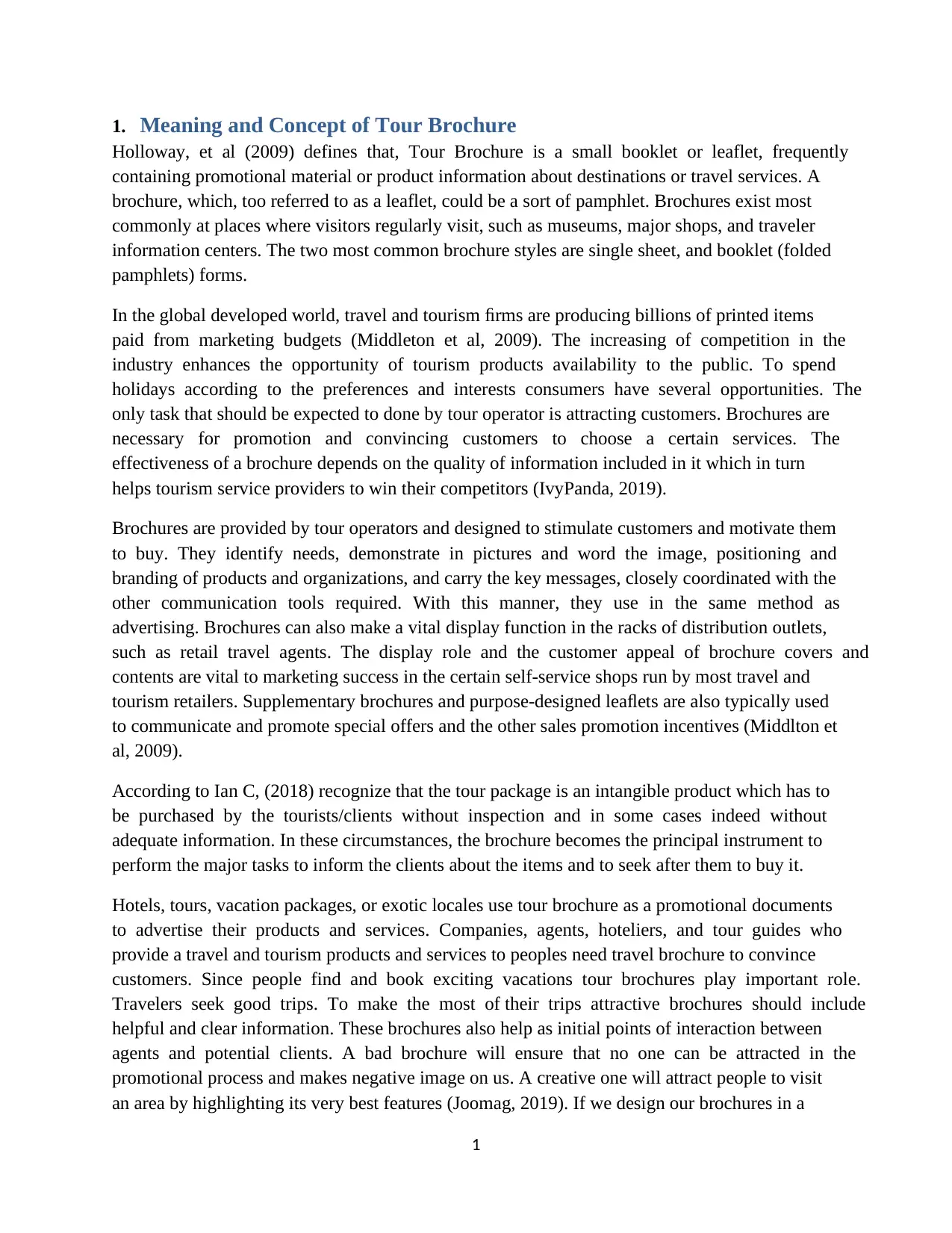
1
1. Meaning and Concept of Tour Brochure
Holloway, et al (2009) defines that, Tour Brochure is a small booklet or leaflet, frequently
containing promotional material or product information about destinations or travel services. A
brochure, which, too referred to as a leaflet, could be a sort of pamphlet. Brochures exist most
commonly at places where visitors regularly visit, such as museums, major shops, and traveler
information centers. The two most common brochure styles are single sheet, and booklet (folded
pamphlets) forms.
In the global developed world, travel and tourism firms are producing billions of printed items
paid from marketing budgets (Middleton et al, 2009). The increasing of competition in the
industry enhances the opportunity of tourism products availability to the public. To spend
holidays according to the preferences and interests consumers have several opportunities. The
only task that should be expected to done by tour operator is attracting customers. Brochures are
necessary for promotion and convincing customers to choose a certain services. The
effectiveness of a brochure depends on the quality of information included in it which in turn
helps tourism service providers to win their competitors (IvyPanda, 2019).
Brochures are provided by tour operators and designed to stimulate customers and motivate them
to buy. They identify needs, demonstrate in pictures and word the image, positioning and
branding of products and organizations, and carry the key messages, closely coordinated with the
other communication tools required. With this manner, they use in the same method as
advertising. Brochures can also make a vital display function in the racks of distribution outlets,
such as retail travel agents. The display role and the customer appeal of brochure covers and
contents are vital to marketing success in the certain self-service shops run by most travel and
tourism retailers. Supplementary brochures and purpose-designed leaflets are also typically used
to communicate and promote special offers and the other sales promotion incentives (Middlton et
al, 2009).
According to Ian C, (2018) recognize that the tour package is an intangible product which has to
be purchased by the tourists/clients without inspection and in some cases indeed without
adequate information. In these circumstances, the brochure becomes the principal instrument to
perform the major tasks to inform the clients about the items and to seek after them to buy it.
Hotels, tours, vacation packages, or exotic locales use tour brochure as a promotional documents
to advertise their products and services. Companies, agents, hoteliers, and tour guides who
provide a travel and tourism products and services to peoples need travel brochure to convince
customers. Since people find and book exciting vacations tour brochures play important role.
Travelers seek good trips. To make the most of their trips attractive brochures should include
helpful and clear information. These brochures also help as initial points of interaction between
agents and potential clients. A bad brochure will ensure that no one can be attracted in the
promotional process and makes negative image on us. A creative one will attract people to visit
an area by highlighting its very best features (Joomag, 2019). If we design our brochures in a
1. Meaning and Concept of Tour Brochure
Holloway, et al (2009) defines that, Tour Brochure is a small booklet or leaflet, frequently
containing promotional material or product information about destinations or travel services. A
brochure, which, too referred to as a leaflet, could be a sort of pamphlet. Brochures exist most
commonly at places where visitors regularly visit, such as museums, major shops, and traveler
information centers. The two most common brochure styles are single sheet, and booklet (folded
pamphlets) forms.
In the global developed world, travel and tourism firms are producing billions of printed items
paid from marketing budgets (Middleton et al, 2009). The increasing of competition in the
industry enhances the opportunity of tourism products availability to the public. To spend
holidays according to the preferences and interests consumers have several opportunities. The
only task that should be expected to done by tour operator is attracting customers. Brochures are
necessary for promotion and convincing customers to choose a certain services. The
effectiveness of a brochure depends on the quality of information included in it which in turn
helps tourism service providers to win their competitors (IvyPanda, 2019).
Brochures are provided by tour operators and designed to stimulate customers and motivate them
to buy. They identify needs, demonstrate in pictures and word the image, positioning and
branding of products and organizations, and carry the key messages, closely coordinated with the
other communication tools required. With this manner, they use in the same method as
advertising. Brochures can also make a vital display function in the racks of distribution outlets,
such as retail travel agents. The display role and the customer appeal of brochure covers and
contents are vital to marketing success in the certain self-service shops run by most travel and
tourism retailers. Supplementary brochures and purpose-designed leaflets are also typically used
to communicate and promote special offers and the other sales promotion incentives (Middlton et
al, 2009).
According to Ian C, (2018) recognize that the tour package is an intangible product which has to
be purchased by the tourists/clients without inspection and in some cases indeed without
adequate information. In these circumstances, the brochure becomes the principal instrument to
perform the major tasks to inform the clients about the items and to seek after them to buy it.
Hotels, tours, vacation packages, or exotic locales use tour brochure as a promotional documents
to advertise their products and services. Companies, agents, hoteliers, and tour guides who
provide a travel and tourism products and services to peoples need travel brochure to convince
customers. Since people find and book exciting vacations tour brochures play important role.
Travelers seek good trips. To make the most of their trips attractive brochures should include
helpful and clear information. These brochures also help as initial points of interaction between
agents and potential clients. A bad brochure will ensure that no one can be attracted in the
promotional process and makes negative image on us. A creative one will attract people to visit
an area by highlighting its very best features (Joomag, 2019). If we design our brochures in a
⊘ This is a preview!⊘
Do you want full access?
Subscribe today to unlock all pages.

Trusted by 1+ million students worldwide
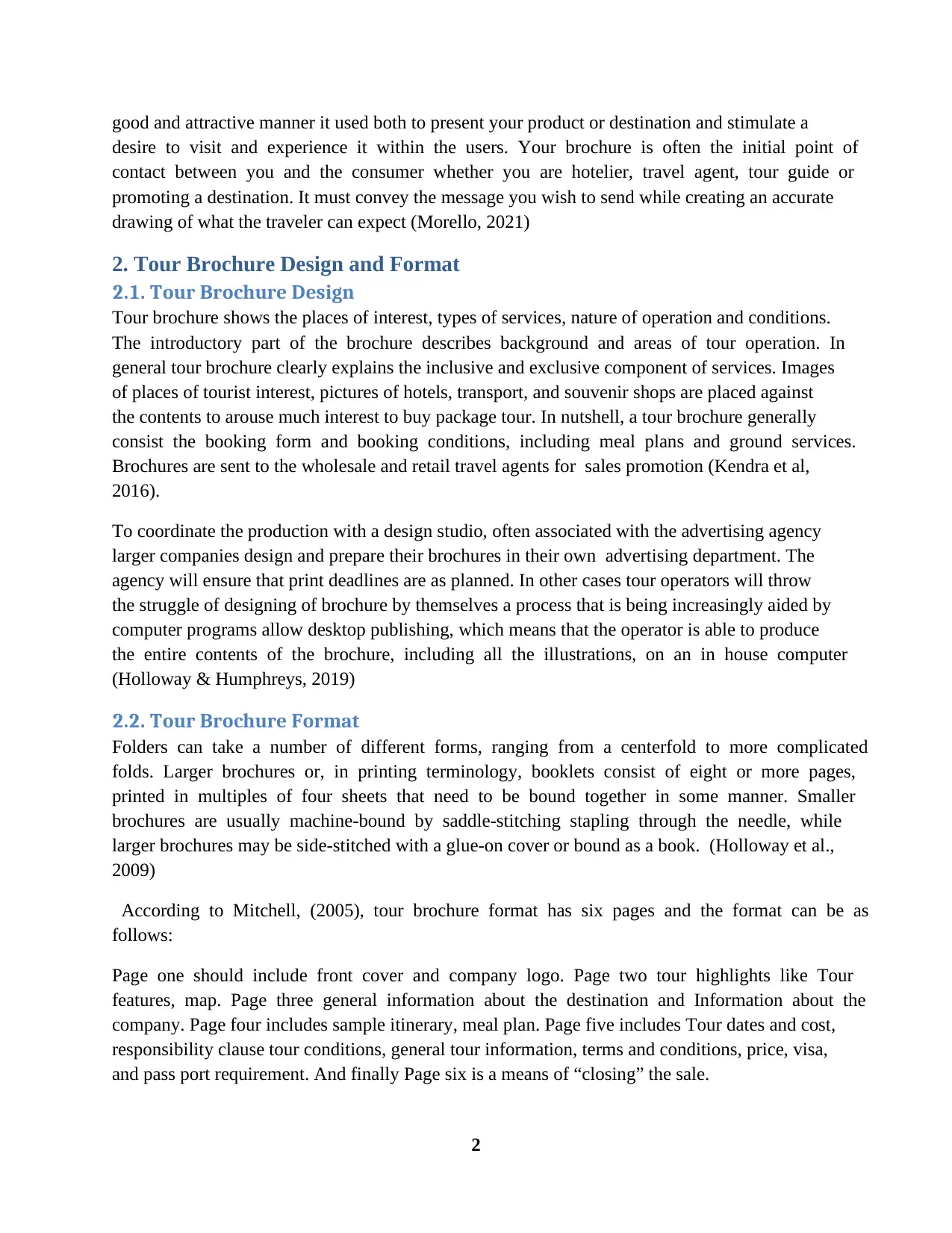
2
good and attractive manner it used both to present your product or destination and stimulate a
desire to visit and experience it within the users. Your brochure is often the initial point of
contact between you and the consumer whether you are hotelier, travel agent, tour guide or
promoting a destination. It must convey the message you wish to send while creating an accurate
drawing of what the traveler can expect (Morello, 2021)
2. Tour Brochure Design and Format
2.1. Tour Brochure Design
Tour brochure shows the places of interest, types of services, nature of operation and conditions.
The introductory part of the brochure describes background and areas of tour operation. In
general tour brochure clearly explains the inclusive and exclusive component of services. Images
of places of tourist interest, pictures of hotels, transport, and souvenir shops are placed against
the contents to arouse much interest to buy package tour. In nutshell, a tour brochure generally
consist the booking form and booking conditions, including meal plans and ground services.
Brochures are sent to the wholesale and retail travel agents for sales promotion (Kendra et al,
2016).
To coordinate the production with a design studio, often associated with the advertising agency
larger companies design and prepare their brochures in their own advertising department. The
agency will ensure that print deadlines are as planned. In other cases tour operators will throw
the struggle of designing of brochure by themselves a process that is being increasingly aided by
computer programs allow desktop publishing, which means that the operator is able to produce
the entire contents of the brochure, including all the illustrations, on an in house computer
(Holloway & Humphreys, 2019)
2.2. Tour Brochure Format
Folders can take a number of different forms, ranging from a centerfold to more complicated
folds. Larger brochures or, in printing terminology, booklets consist of eight or more pages,
printed in multiples of four sheets that need to be bound together in some manner. Smaller
brochures are usually machine-bound by saddle-stitching stapling through the needle, while
larger brochures may be side-stitched with a glue-on cover or bound as a book. (Holloway et al.,
2009)
According to Mitchell, (2005), tour brochure format has six pages and the format can be as
follows:
Page one should include front cover and company logo. Page two tour highlights like Tour
features, map. Page three general information about the destination and Information about the
company. Page four includes sample itinerary, meal plan. Page five includes Tour dates and cost,
responsibility clause tour conditions, general tour information, terms and conditions, price, visa,
and pass port requirement. And finally Page six is a means of “closing” the sale.
good and attractive manner it used both to present your product or destination and stimulate a
desire to visit and experience it within the users. Your brochure is often the initial point of
contact between you and the consumer whether you are hotelier, travel agent, tour guide or
promoting a destination. It must convey the message you wish to send while creating an accurate
drawing of what the traveler can expect (Morello, 2021)
2. Tour Brochure Design and Format
2.1. Tour Brochure Design
Tour brochure shows the places of interest, types of services, nature of operation and conditions.
The introductory part of the brochure describes background and areas of tour operation. In
general tour brochure clearly explains the inclusive and exclusive component of services. Images
of places of tourist interest, pictures of hotels, transport, and souvenir shops are placed against
the contents to arouse much interest to buy package tour. In nutshell, a tour brochure generally
consist the booking form and booking conditions, including meal plans and ground services.
Brochures are sent to the wholesale and retail travel agents for sales promotion (Kendra et al,
2016).
To coordinate the production with a design studio, often associated with the advertising agency
larger companies design and prepare their brochures in their own advertising department. The
agency will ensure that print deadlines are as planned. In other cases tour operators will throw
the struggle of designing of brochure by themselves a process that is being increasingly aided by
computer programs allow desktop publishing, which means that the operator is able to produce
the entire contents of the brochure, including all the illustrations, on an in house computer
(Holloway & Humphreys, 2019)
2.2. Tour Brochure Format
Folders can take a number of different forms, ranging from a centerfold to more complicated
folds. Larger brochures or, in printing terminology, booklets consist of eight or more pages,
printed in multiples of four sheets that need to be bound together in some manner. Smaller
brochures are usually machine-bound by saddle-stitching stapling through the needle, while
larger brochures may be side-stitched with a glue-on cover or bound as a book. (Holloway et al.,
2009)
According to Mitchell, (2005), tour brochure format has six pages and the format can be as
follows:
Page one should include front cover and company logo. Page two tour highlights like Tour
features, map. Page three general information about the destination and Information about the
company. Page four includes sample itinerary, meal plan. Page five includes Tour dates and cost,
responsibility clause tour conditions, general tour information, terms and conditions, price, visa,
and pass port requirement. And finally Page six is a means of “closing” the sale.
Paraphrase This Document
Need a fresh take? Get an instant paraphrase of this document with our AI Paraphraser
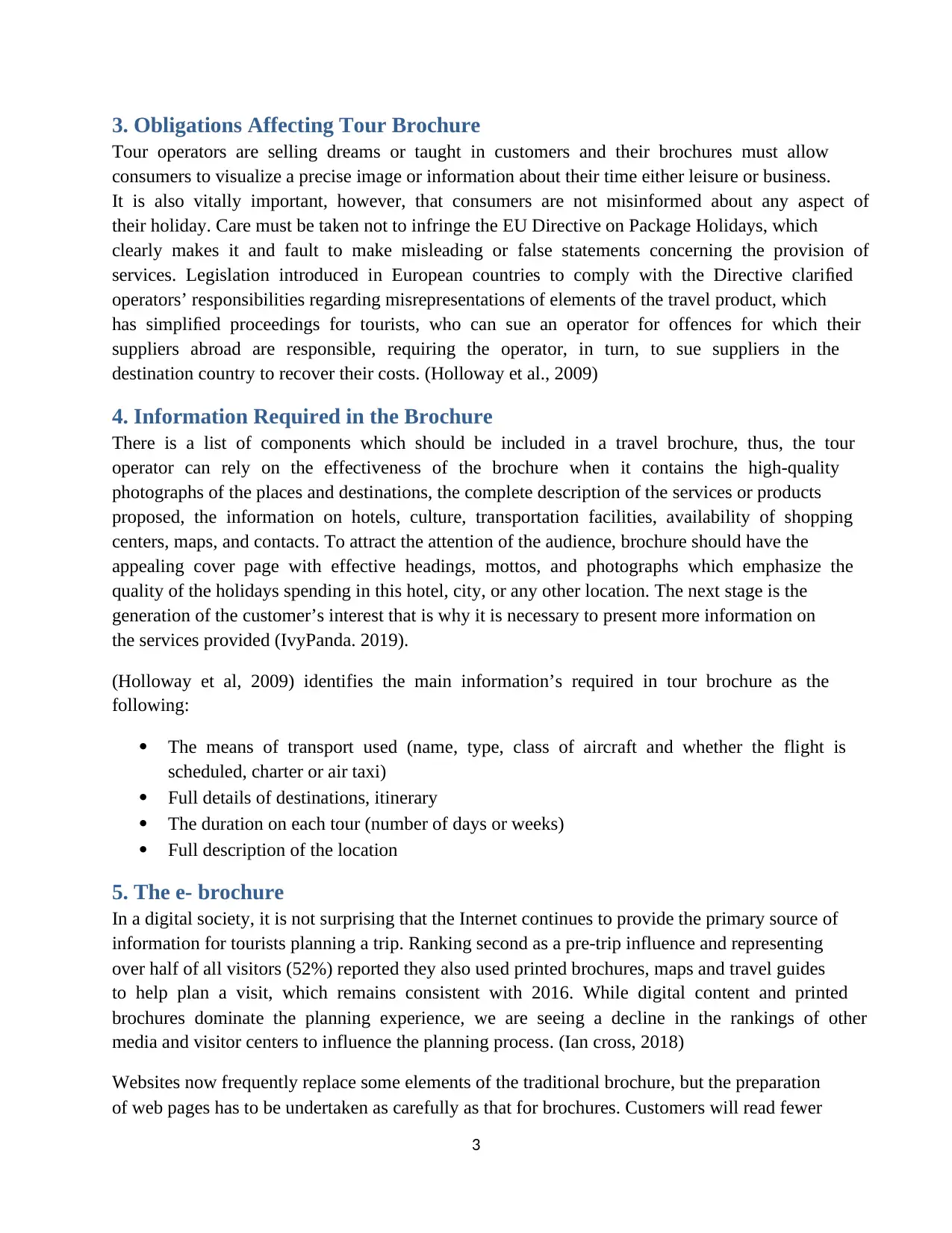
3
3. Obligations Affecting Tour Brochure
Tour operators are selling dreams or taught in customers and their brochures must allow
consumers to visualize a precise image or information about their time either leisure or business.
It is also vitally important, however, that consumers are not misinformed about any aspect of
their holiday. Care must be taken not to infringe the EU Directive on Package Holidays, which
clearly makes it and fault to make misleading or false statements concerning the provision of
services. Legislation introduced in European countries to comply with the Directive clarified
operators’ responsibilities regarding misrepresentations of elements of the travel product, which
has simplified proceedings for tourists, who can sue an operator for offences for which their
suppliers abroad are responsible, requiring the operator, in turn, to sue suppliers in the
destination country to recover their costs. (Holloway et al., 2009)
4. Information Required in the Brochure
There is a list of components which should be included in a travel brochure, thus, the tour
operator can rely on the effectiveness of the brochure when it contains the high-quality
photographs of the places and destinations, the complete description of the services or products
proposed, the information on hotels, culture, transportation facilities, availability of shopping
centers, maps, and contacts. To attract the attention of the audience, brochure should have the
appealing cover page with effective headings, mottos, and photographs which emphasize the
quality of the holidays spending in this hotel, city, or any other location. The next stage is the
generation of the customer’s interest that is why it is necessary to present more information on
the services provided (IvyPanda. 2019).
(Holloway et al, 2009) identifies the main information’s required in tour brochure as the
following:
The means of transport used (name, type, class of aircraft and whether the flight is
scheduled, charter or air taxi)
Full details of destinations, itinerary
The duration on each tour (number of days or weeks)
Full description of the location
5. The e- brochure
In a digital society, it is not surprising that the Internet continues to provide the primary source of
information for tourists planning a trip. Ranking second as a pre-trip influence and representing
over half of all visitors (52%) reported they also used printed brochures, maps and travel guides
to help plan a visit, which remains consistent with 2016. While digital content and printed
brochures dominate the planning experience, we are seeing a decline in the rankings of other
media and visitor centers to influence the planning process. (Ian cross, 2018)
Websites now frequently replace some elements of the traditional brochure, but the preparation
of web pages has to be undertaken as carefully as that for brochures. Customers will read fewer
3. Obligations Affecting Tour Brochure
Tour operators are selling dreams or taught in customers and their brochures must allow
consumers to visualize a precise image or information about their time either leisure or business.
It is also vitally important, however, that consumers are not misinformed about any aspect of
their holiday. Care must be taken not to infringe the EU Directive on Package Holidays, which
clearly makes it and fault to make misleading or false statements concerning the provision of
services. Legislation introduced in European countries to comply with the Directive clarified
operators’ responsibilities regarding misrepresentations of elements of the travel product, which
has simplified proceedings for tourists, who can sue an operator for offences for which their
suppliers abroad are responsible, requiring the operator, in turn, to sue suppliers in the
destination country to recover their costs. (Holloway et al., 2009)
4. Information Required in the Brochure
There is a list of components which should be included in a travel brochure, thus, the tour
operator can rely on the effectiveness of the brochure when it contains the high-quality
photographs of the places and destinations, the complete description of the services or products
proposed, the information on hotels, culture, transportation facilities, availability of shopping
centers, maps, and contacts. To attract the attention of the audience, brochure should have the
appealing cover page with effective headings, mottos, and photographs which emphasize the
quality of the holidays spending in this hotel, city, or any other location. The next stage is the
generation of the customer’s interest that is why it is necessary to present more information on
the services provided (IvyPanda. 2019).
(Holloway et al, 2009) identifies the main information’s required in tour brochure as the
following:
The means of transport used (name, type, class of aircraft and whether the flight is
scheduled, charter or air taxi)
Full details of destinations, itinerary
The duration on each tour (number of days or weeks)
Full description of the location
5. The e- brochure
In a digital society, it is not surprising that the Internet continues to provide the primary source of
information for tourists planning a trip. Ranking second as a pre-trip influence and representing
over half of all visitors (52%) reported they also used printed brochures, maps and travel guides
to help plan a visit, which remains consistent with 2016. While digital content and printed
brochures dominate the planning experience, we are seeing a decline in the rankings of other
media and visitor centers to influence the planning process. (Ian cross, 2018)
Websites now frequently replace some elements of the traditional brochure, but the preparation
of web pages has to be undertaken as carefully as that for brochures. Customers will read fewer
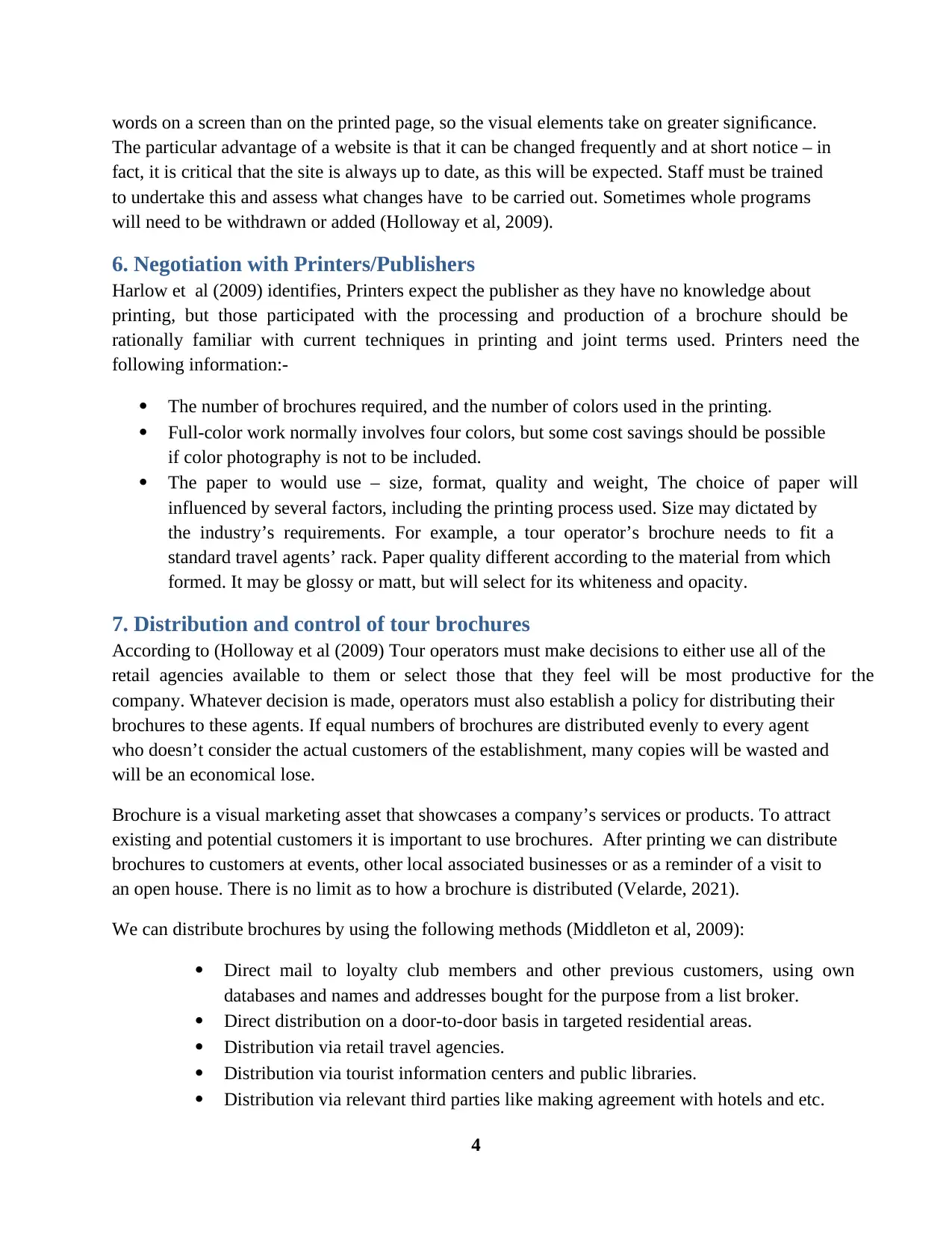
4
words on a screen than on the printed page, so the visual elements take on greater significance.
The particular advantage of a website is that it can be changed frequently and at short notice – in
fact, it is critical that the site is always up to date, as this will be expected. Staff must be trained
to undertake this and assess what changes have to be carried out. Sometimes whole programs
will need to be withdrawn or added (Holloway et al, 2009).
6. Negotiation with Printers/Publishers
Harlow et al (2009) identifies, Printers expect the publisher as they have no knowledge about
printing, but those participated with the processing and production of a brochure should be
rationally familiar with current techniques in printing and joint terms used. Printers need the
following information:-
The number of brochures required, and the number of colors used in the printing.
Full-color work normally involves four colors, but some cost savings should be possible
if color photography is not to be included.
The paper to would use – size, format, quality and weight, The choice of paper will
influenced by several factors, including the printing process used. Size may dictated by
the industry’s requirements. For example, a tour operator’s brochure needs to fit a
standard travel agents’ rack. Paper quality different according to the material from which
formed. It may be glossy or matt, but will select for its whiteness and opacity.
7. Distribution and control of tour brochures
According to (Holloway et al (2009) Tour operators must make decisions to either use all of the
retail agencies available to them or select those that they feel will be most productive for the
company. Whatever decision is made, operators must also establish a policy for distributing their
brochures to these agents. If equal numbers of brochures are distributed evenly to every agent
who doesn’t consider the actual customers of the establishment, many copies will be wasted and
will be an economical lose.
Brochure is a visual marketing asset that showcases a company’s services or products. To attract
existing and potential customers it is important to use brochures. After printing we can distribute
brochures to customers at events, other local associated businesses or as a reminder of a visit to
an open house. There is no limit as to how a brochure is distributed (Velarde, 2021).
We can distribute brochures by using the following methods (Middleton et al, 2009):
Direct mail to loyalty club members and other previous customers, using own
databases and names and addresses bought for the purpose from a list broker.
Direct distribution on a door-to-door basis in targeted residential areas.
Distribution via retail travel agencies.
Distribution via tourist information centers and public libraries.
Distribution via relevant third parties like making agreement with hotels and etc.
words on a screen than on the printed page, so the visual elements take on greater significance.
The particular advantage of a website is that it can be changed frequently and at short notice – in
fact, it is critical that the site is always up to date, as this will be expected. Staff must be trained
to undertake this and assess what changes have to be carried out. Sometimes whole programs
will need to be withdrawn or added (Holloway et al, 2009).
6. Negotiation with Printers/Publishers
Harlow et al (2009) identifies, Printers expect the publisher as they have no knowledge about
printing, but those participated with the processing and production of a brochure should be
rationally familiar with current techniques in printing and joint terms used. Printers need the
following information:-
The number of brochures required, and the number of colors used in the printing.
Full-color work normally involves four colors, but some cost savings should be possible
if color photography is not to be included.
The paper to would use – size, format, quality and weight, The choice of paper will
influenced by several factors, including the printing process used. Size may dictated by
the industry’s requirements. For example, a tour operator’s brochure needs to fit a
standard travel agents’ rack. Paper quality different according to the material from which
formed. It may be glossy or matt, but will select for its whiteness and opacity.
7. Distribution and control of tour brochures
According to (Holloway et al (2009) Tour operators must make decisions to either use all of the
retail agencies available to them or select those that they feel will be most productive for the
company. Whatever decision is made, operators must also establish a policy for distributing their
brochures to these agents. If equal numbers of brochures are distributed evenly to every agent
who doesn’t consider the actual customers of the establishment, many copies will be wasted and
will be an economical lose.
Brochure is a visual marketing asset that showcases a company’s services or products. To attract
existing and potential customers it is important to use brochures. After printing we can distribute
brochures to customers at events, other local associated businesses or as a reminder of a visit to
an open house. There is no limit as to how a brochure is distributed (Velarde, 2021).
We can distribute brochures by using the following methods (Middleton et al, 2009):
Direct mail to loyalty club members and other previous customers, using own
databases and names and addresses bought for the purpose from a list broker.
Direct distribution on a door-to-door basis in targeted residential areas.
Distribution via retail travel agencies.
Distribution via tourist information centers and public libraries.
Distribution via relevant third parties like making agreement with hotels and etc.
⊘ This is a preview!⊘
Do you want full access?
Subscribe today to unlock all pages.

Trusted by 1+ million students worldwide
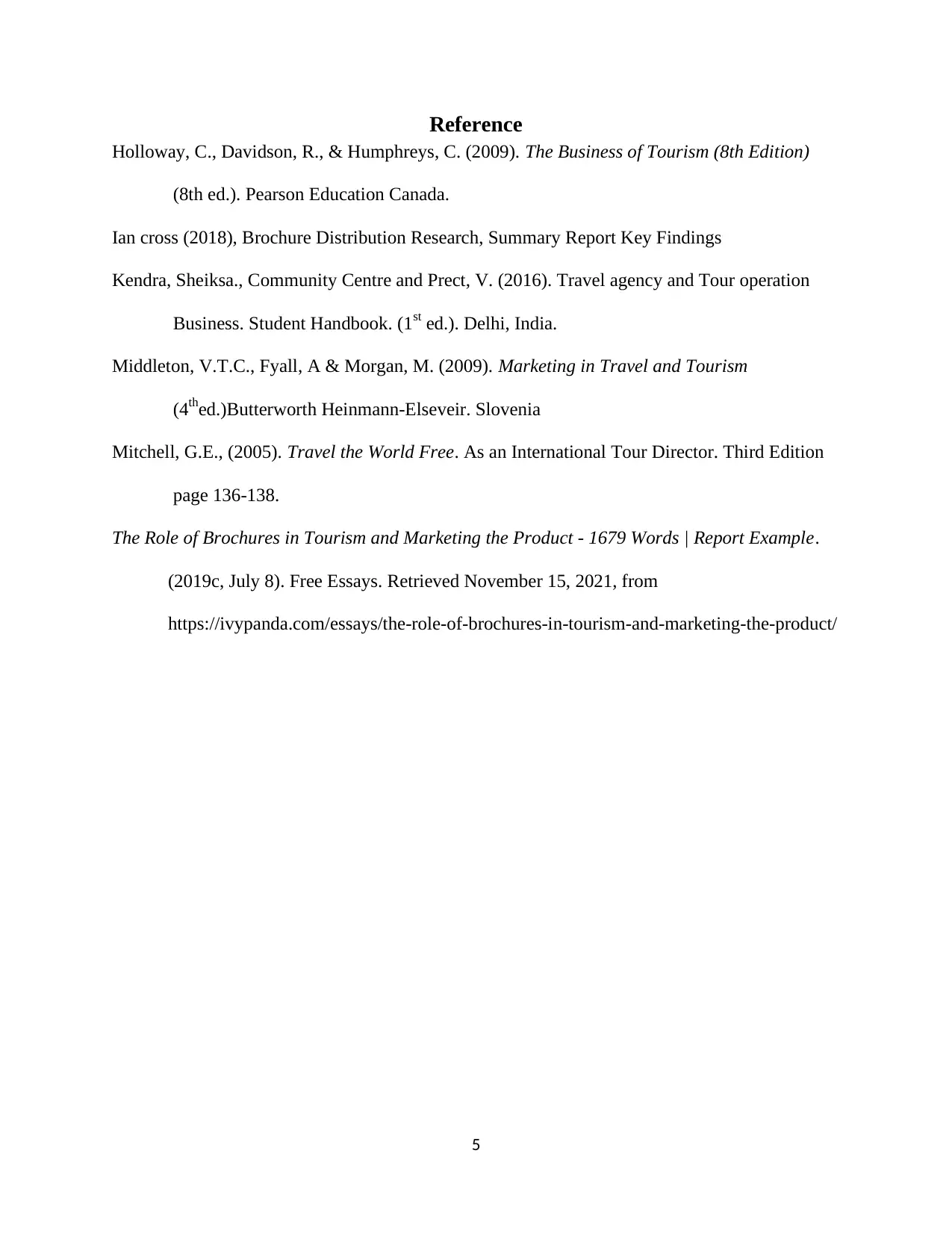
5
Reference
Holloway, C., Davidson, R., & Humphreys, C. (2009). The Business of Tourism (8th Edition)
(8th ed.). Pearson Education Canada.
Ian cross (2018), Brochure Distribution Research, Summary Report Key Findings
Kendra, Sheiksa., Community Centre and Prect, V. (2016). Travel agency and Tour operation
Business. Student Handbook. (1st ed.). Delhi, India.
Middleton, V.T.C., Fyall, A & Morgan, M. (2009). Marketing in Travel and Tourism
(4thed.)Butterworth Heinmann-Elseveir. Slovenia
Mitchell, G.E., (2005). Travel the World Free. As an International Tour Director. Third Edition
page 136-138.
The Role of Brochures in Tourism and Marketing the Product - 1679 Words | Report Example.
(2019c, July 8). Free Essays. Retrieved November 15, 2021, from
https://ivypanda.com/essays/the-role-of-brochures-in-tourism-and-marketing-the-product/
Reference
Holloway, C., Davidson, R., & Humphreys, C. (2009). The Business of Tourism (8th Edition)
(8th ed.). Pearson Education Canada.
Ian cross (2018), Brochure Distribution Research, Summary Report Key Findings
Kendra, Sheiksa., Community Centre and Prect, V. (2016). Travel agency and Tour operation
Business. Student Handbook. (1st ed.). Delhi, India.
Middleton, V.T.C., Fyall, A & Morgan, M. (2009). Marketing in Travel and Tourism
(4thed.)Butterworth Heinmann-Elseveir. Slovenia
Mitchell, G.E., (2005). Travel the World Free. As an International Tour Director. Third Edition
page 136-138.
The Role of Brochures in Tourism and Marketing the Product - 1679 Words | Report Example.
(2019c, July 8). Free Essays. Retrieved November 15, 2021, from
https://ivypanda.com/essays/the-role-of-brochures-in-tourism-and-marketing-the-product/
1 out of 7
Related Documents
Your All-in-One AI-Powered Toolkit for Academic Success.
+13062052269
info@desklib.com
Available 24*7 on WhatsApp / Email
![[object Object]](/_next/static/media/star-bottom.7253800d.svg)
Unlock your academic potential
Copyright © 2020–2025 A2Z Services. All Rights Reserved. Developed and managed by ZUCOL.





